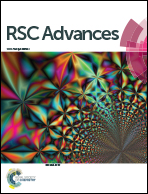Selective CO2 reduction to HCOOH on a Pt/In2O3/g-C3N4 multifunctional visible-photocatalyst†
Abstract
Selective photocatalytic reduction of CO2 has been regarded as one of the most amazing ways for re-using CO2. However, its application is still limited by the low CO2 conversion efficiency. This work developed a novel Pt/In2O3/g-C3N4 multifunctional catalyst, which exhibited high activity and selectivity to HCOOH during photocatalytic CO2 reduction under visible light irradiation owing to the synergistic effect between photocatalyst, thermocatalyst, and heterojunctions. Both In2O3 and g-C3N4 acted as visible photocatalysts, in which porous g-C3N4 facilitated H2 production from water splitting while the In2O3 nanosheets embedded in g-C3N4 pores favored CO2 fixation and H adsorption onto the Lewis acid sites. Besides, the In2O3/g-C3N4 heterojunctions could efficiently inhibit the photoelectron–hole recombination, leading to enhanced quantum efficiency. The Pt could act as a co-catalyst in H2 production from photocatalytic water splitting and also accelerated electron transfer to inhibit electron–hole recombination and generated a plasma effect. More importantly, the Pt could activate H atoms and CO2 molecules toward the formation of HCOOH. At normal pressure and room temperature, the TON of HCOOH in CO2 conversion was 63.1 μmol g−1 h−1 and could reach up to 736.3 μmol g−1 h−1 at 40 atm.



 Please wait while we load your content...
Please wait while we load your content...